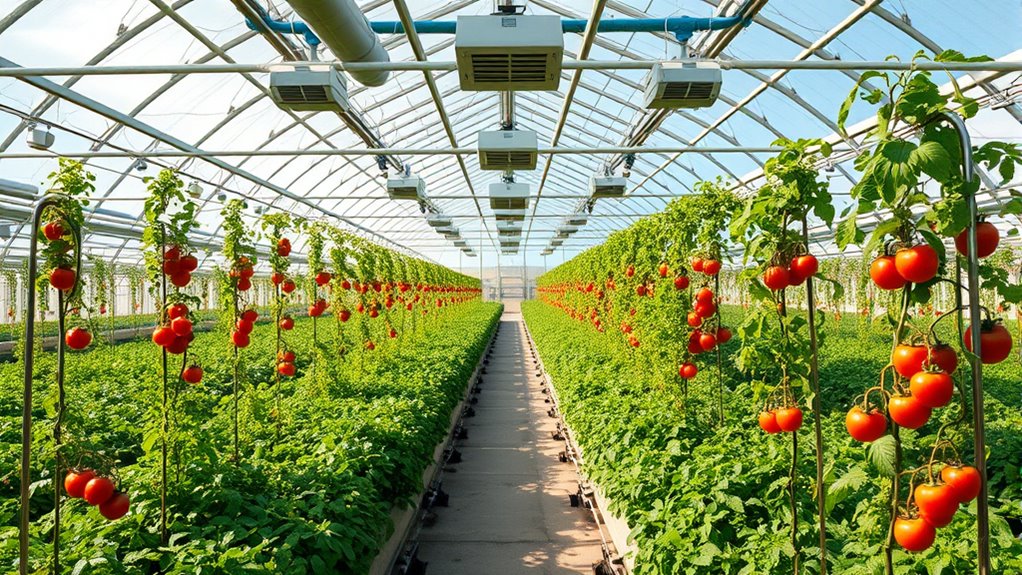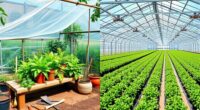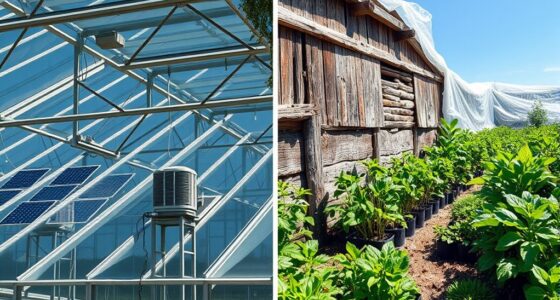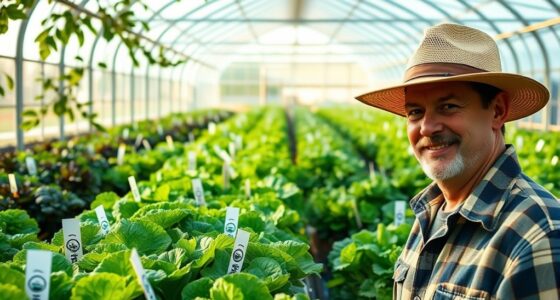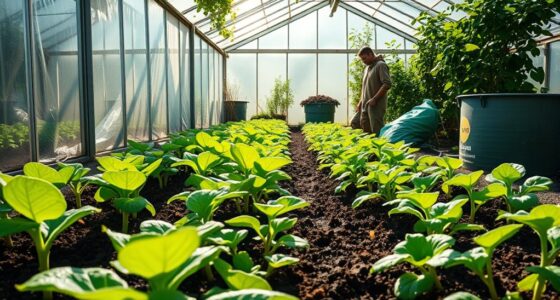To achieve year-round greenhouse production, you need to plan seasonally by adjusting environmental controls, implementing crop rotation, and managing pests proactively. Use supplemental heating during colder months and shading in summer to keep conditions ideal. Rotate crops to prevent soil exhaustion and disrupt pests, while natural pest management helps reduce chemical use. Fine-tuning these strategies ensures continuous, healthy yields all year—stay with us to learn how to make this process even smoother.
Key Takeaways
- Implement crop rotation to prevent soil exhaustion and disrupt pest cycles across seasons.
- Adjust environmental controls like lighting, heating, and shading to optimize growth year-round.
- Schedule pest management strategies based on seasonal pest prevalence and pest life cycles.
- Use strategic timing for planting and harvesting to maintain a continuous supply of produce.
- Incorporate integrated pest management and environmental practices to reduce chemical use and enhance crop health.
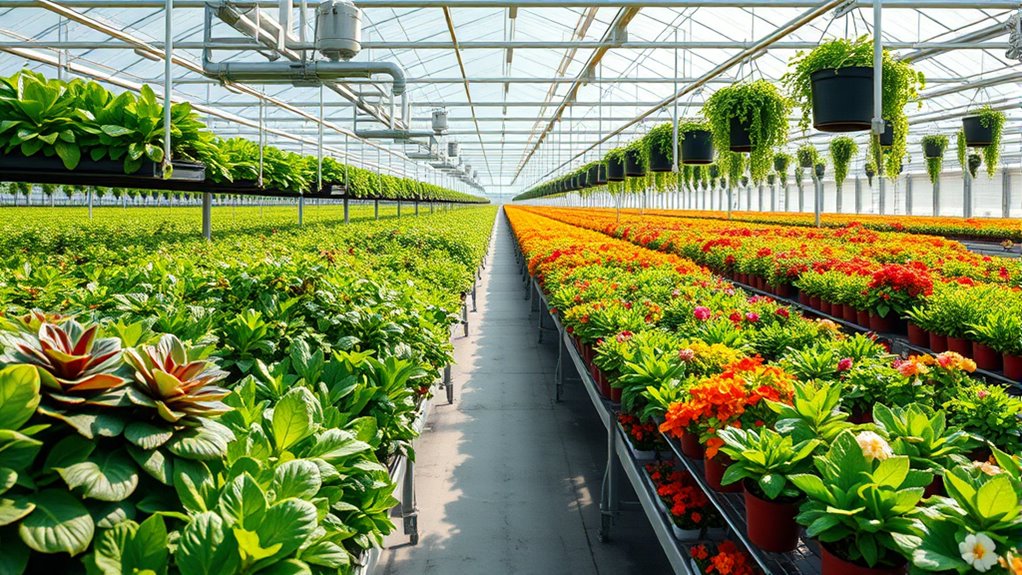
Seasonal planning in greenhouses is crucial for maximizing crop yields and maintaining healthy plants throughout the year. When you plan your planting schedule carefully, you can secure a steady supply of fresh produce while reducing issues like disease buildup and pest infestations. One of the most effective strategies you can implement is crop rotation. By changing the types of crops you grow in specific beds each season, you prevent soil exhaustion and disrupt pest and disease cycles. For example, if you grow leafy greens in one area this season, rotate to root vegetables or legumes the next. This not only enhances soil health but also reduces the likelihood of pests that target particular plant families establishing a foothold.
Implement crop rotation each season to boost soil health and prevent pests in your greenhouse.
In addition to crop rotation, pest management becomes more straightforward when you plan your seasons thoughtfully. Knowing which pests are prevalent during specific times of the year allows you to prepare and implement targeted interventions early. For instance, if aphids tend to invade during early spring, you can introduce natural predators or apply organic treatments preemptively. Maintaining a clean, organized greenhouse environment is essential; regular sanitation helps eliminate pest hiding spots and reduces the chances of infestations spreading from one crop cycle to the next. Properly timed pest management strategies, aligned with your seasonal calendar, go a long way in reducing chemical use and promoting healthier plants. Additionally, being aware of pest life cycles allows you to synchronize your control measures more effectively, leading to better outcomes.
Your seasonal planning should also consider the different light, temperature, and humidity needs of your crops throughout the year. Adjusting your greenhouse environment accordingly ensures ideal growth conditions, which in turn supports your pest management and crop rotation efforts. For example, during colder months, you might need supplemental heating, while in summer, shading can prevent overheating. This careful control helps keep pests and diseases at bay, as many thrive under specific environmental conditions. Staying ahead of these variables allows you to create a stable environment that supports continuous production.
Furthermore, understanding the cost of equipment such as heaters, fans, and organic pest control supplies can help you budget effectively for year-round production. Properly timing your seasonal fluctuations in resource availability and energy consumption can also optimize your operational efficiency. Additionally, implementing integrated pest management practices reduces reliance on chemical treatments and contributes to a healthier growing environment. Investing in environmental controls like humidity and light regulation can further enhance crop health and pest resistance. Ultimately, your success in year-round greenhouse production hinges on meticulous seasonal planning. By integrating crop rotation and pest management into your schedule, you not only protect your plants but also maximize yields. Planning ahead enables you to anticipate challenges and adapt your practices proactively, ensuring healthy crops and consistent harvests throughout the year. When you approach your greenhouse with a strategic mindset, you optimize your resources, reduce losses, and enjoy the satisfaction of a flourishing, productive environment no matter the season.
Frequently Asked Questions
How Can I Extend the Growing Season Indoors Effectively?
To extend your indoor growing season effectively, you can optimize your setup by using hydroponic systems, which allow precise control over nutrients and environment, boosting growth year-round. Incorporate crop rotation to prevent soil depletion and disease buildup, even indoors. Adjust lighting, temperature, and humidity as needed. These strategies guarantee continuous, healthy production, making your indoor garden more productive and resilient throughout the year.
What Are the Best Crops for Year-Round Greenhouse Production?
You should focus on crop varieties that thrive indoors and meet consistent market demand, like leafy greens, herbs, and fresh herbs, which grow quickly year-round. These crops are adaptable, require less space, and can be harvested multiple times. By selecting the right crop variety based on market demand, you guarantee steady sales and maximize your greenhouse’s productivity, making your year-round production both profitable and sustainable.
How Do I Manage Pests During Off-Peak Seasons?
Think of pest management as a fortress you constantly defend. During off-peak seasons, stay vigilant by implementing integrated pest management strategies, combining cultural, physical, and chemical controls. Use biological pest control, like beneficial insects, to naturally keep pests in check. Regular monitoring and early intervention are your best weapons, preventing small issues from becoming full-blown infestations. This proactive approach keeps your greenhouse resilient year-round.
What Technology Optimizes Climate Control in Greenhouses?
To optimize climate control in your greenhouse, you should invest in advanced technology like automated ventilation systems and climate sensors. These tools actively monitor temperature, humidity, and other environmental factors, adjusting ventilation and heating automatically to maintain ideal conditions. This guarantees your plants thrive year-round, reduces energy costs, and minimizes manual adjustments, giving you a more efficient and consistent growing environment.
How Does Seasonal Planning Impact Greenhouse Energy Costs?
Seasonal planning dramatically slashes your greenhouse energy costs, transforming your operation into a powerhouse of energy efficiency. When you anticipate seasonal shifts, you can optimize heating, cooling, and lighting, preventing waste and slashing expenses. This proactive approach guarantees your energy use aligns perfectly with plant needs, leading to significant cost reduction. Embracing seasonal planning isn’t just smart—it’s the game-changer that turns costly energy bills into lean, efficient operations.
Conclusion
By mastering seasonal planning in your greenhouse, you open the power to grow crops year-round—no matter what Mother Nature throws at you! Imagine having fresh vegetables, vibrant flowers, and lush greenery blooming in every single season, all thanks to your expert planning. It’s like wielding a magic wand that defies time and weather. With perfect seasonal planning, you’ll revolutionize your gardening game and turn your greenhouse into an unstoppable, all-season powerhouse!
